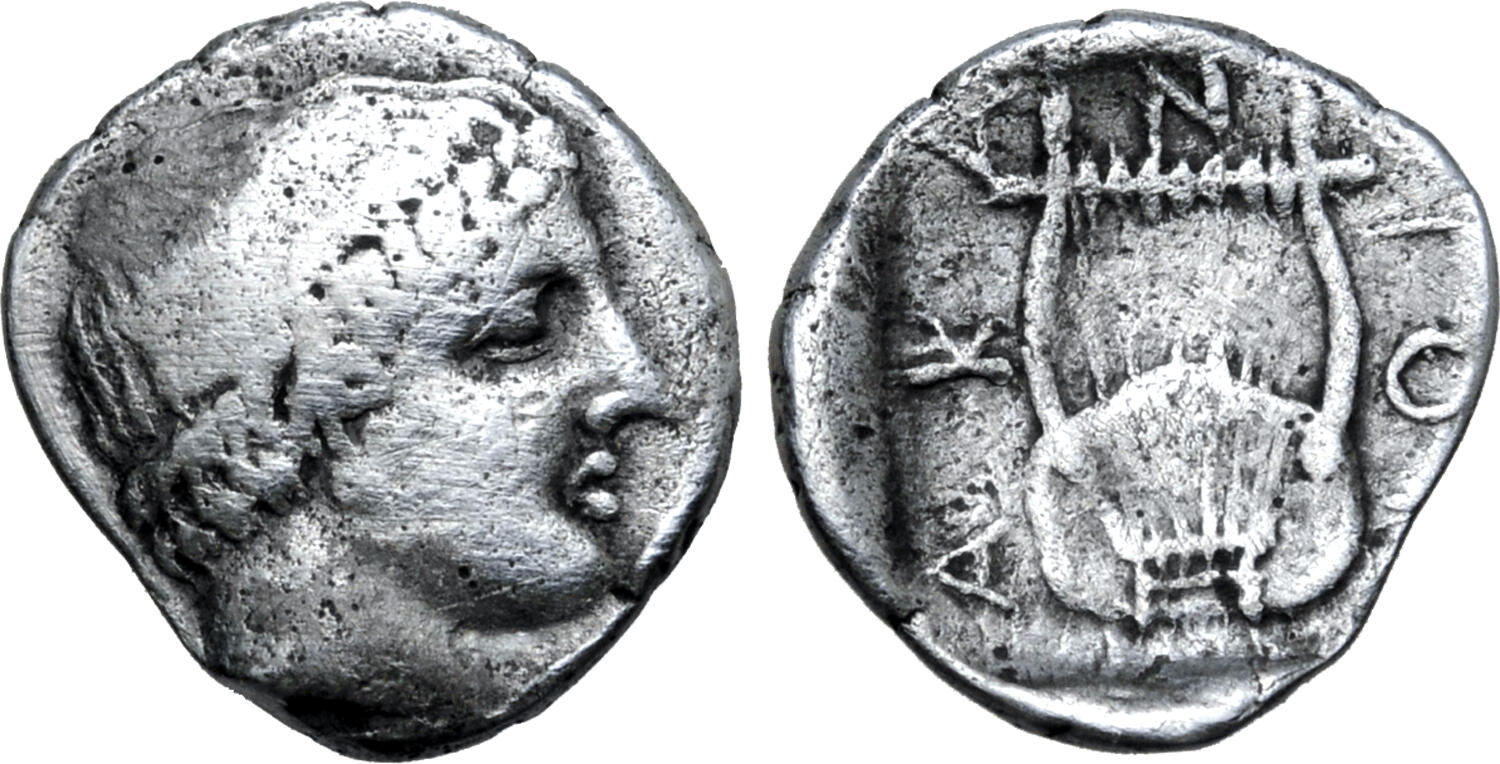S 1822 - Acanthus, silver, obols (Period F) (430-380 BCE)
From SILVER
430 BCE - 380 BCE Silver 557 kg
Description
| ObverseInscription or printing placed on the obverse.: | Laureate head of Apollo right |
| ReverseInscription or printing placed on the reverse.: | AKA-N-ΘΙΟΝ around (Greek).Kithara |
Mint and issuing power
| MintIdentifies the place of manufacture or issue of a numismatic object.: | Acanthus | Ancient regionAncient region.: | Macedon | Modern countryModern country: Greece | AuthorityIdentifies the issuing power. The authority can be "pretended" when the name or the portrait of X is on the coin but he/she was not the issuing power. It can also be "uncertain" when there is no mention of X on the coin but he/she was the issuing power according to the historical sources: |
Chronology
| FromIdentifies the initial date in a range assigned in a numismatic context. | 430 BCE | toIdentifies the final date in a range assigned in a numismatic context.. | 380 BCE | PeriodTime period of the numismatic object.: Classical 480-323 BC |
Physical description
| MetalThe physical material (usually metal) from which an object is made.: | Silver |
Median weightMedian of the weights of numismatic objects (in grams). in grams | 0.60 | DenominationTerm indicating the value of a numismatic object. Examples: tetradrachm, chalkous, denarius.: | obol |
StandardStandard.: |
Image

S1822 Acanthus obols F.jpg [1]
References
| Die study referencePublication of the study: | Tselekas 19961Tselekas 1996, p. 298-300 | ||
| Coin series referenceReference to coin series study: | HGC 3.12HGC 3.1, n° 395 | ||
| Coin series web referenceCoin series web references: | |||
Obverse dies distribution
| FrequencyFrequency of specimen in distribution. ᵖ | Number of obversesNumber of obverse dies. ᵖ (o) | % (o) | Number of coinsNumber of coins. (n) | % (n) | Die nameName(s) of the die(s). |
| 1 | 19 | 65.52 | 19 | 32.2 | 1, 2, 3, 6, 8, 9, 10, 11, 13, 14, 19, 21, 22, 23, 24, 25, 26, 28, 29 |
| 2 | 4 | 13.79 | 8 | 13.56 | 17, 18, 20, 27 |
| 3 | 3 | 10.34 | 9 | 15.25 | 5, 7, 15 |
| 6 | 2 | 6.9 | 12 | 20.34 | 12, 16 |
| 11 | 1 | 3.45 | 11 | 18.64 | 4 |
| Total | 29 of 29 | 100 | 59 of 59 | 99.99 |
Reverse dies distribution
no distribution is available
Quantification
| Number of obversesNumber of obverse dies. ᵖ (o) | 29 | Number of singletons (o1)The number of singleton coins. ᵖ | 19 |
| Number of reverse diesNumber of reverse dies. (r) | 27 | Number of coinsNumber of coins. (n) | 59 |
| Coins per obverse dieNumber of coins per obverse die. (n/o) | 2.03 | Coins per reverse dieNumber of coins per reverse die. (n/r) | 2.19 |
| Reverse per obverse ratioRatio of obverse dies divided by reverse dies. (r/o) | 0.93 | Percentage of singletons (o1)number of coins (n) divided by the number of singletons (o1) ᵖ | 65.52 % |
| Original number of dies (O) (Carter 1983 formula)The estimation of the number of coins according to Carter 1983 ᵖ | 46.43 | Coins struck if 20,000 as average productivity per dieCoins made if the average productivity for obverses (according to Carter) is 20,000. ᵖ | 928,600 |
| Original number of dies (O) (Esty 2011 formula)The estimation of the number of coins according to the singleton formula in Esty 2011 ᵖ (O) | 57.03 | Survival rate if 20,000 as average productivity per dieSurvival rate if average productivity is 20,000. ᵖ | 0.00006 |
| Coverage (o = % of O) (Esty 1984 formula)Esty 1984 - coverage (% of O) ᵖ (o = % of O) | 67.8% | Die productivity if survival rate 1/2,000Average productivity if survival rate is 1/2,000. ᵖ | 2,541.46 |
| Weight of silver (in kg) if 20,000 coins per die (O = Carter formula)Carter 1983 * Median weight * 20000 (*10 if gold or electrum) ᵖ | 557 kg <br /> 557 kg | Die productivity if survival rate 1/5,000Average productivity if survival rate is 1/5,000. ᵖ | 6,353.65 |
Remarks
Most likely one single workstation